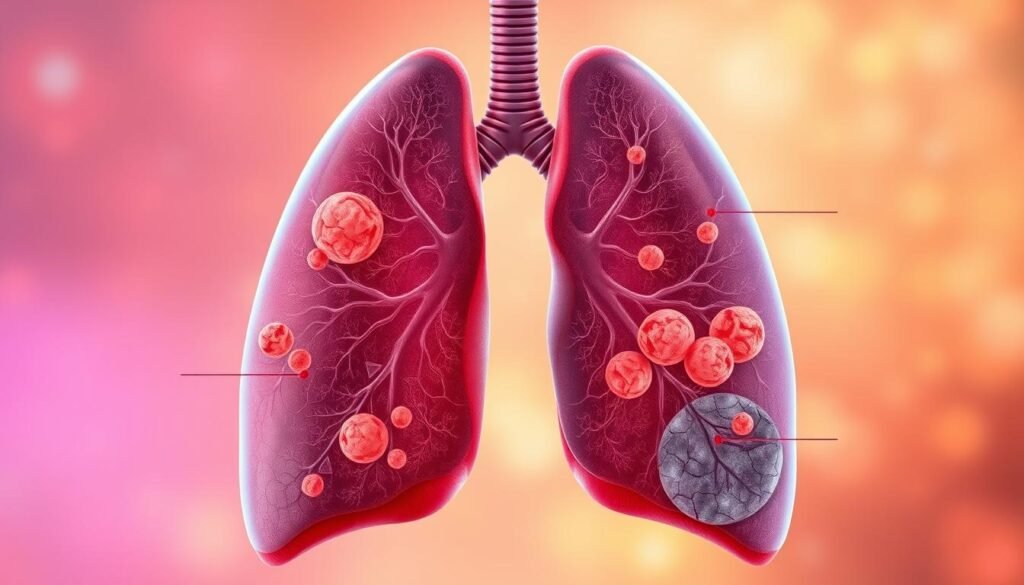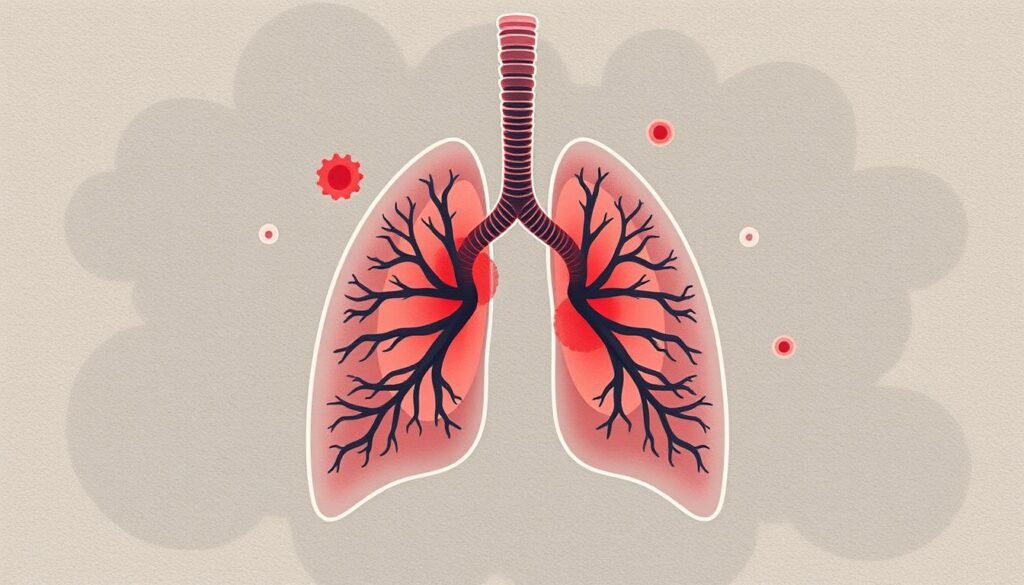About 7% of adults in the U.S. have chronic obstructive pulmonary disease (COPD). This fact shows how common chronic lung diseases are. They are also the fourth leading cause of death. Chronic lung diseases include conditions like asthma, COPD, and bronchitis. These can deeply affect how the lungs work. They make life harder and can lead to serious health problems.
It’s important to see how chronic lung diseases and past lung infections are linked. Many respiratory illnesses come from environmental pollution, genes, and especially, previous infections. These infections can damage the lungs long-term, making it easier for chronic diseases to start. To learn more, visit this informative resource. Knowing this link helps in better managing these diseases and improving lives.
Key Takeaways
- Chronic lung diseases affect about 7% of adults in the U.S., with COPD being a leading cause of death.
- Previous lung infections can significantly impact lung health and contribute to chronic illnesses.
- Environmental factors, smoking, and genetic predispositions are key contributors to chronic lung diseases.
- Effective management strategies are vital for improving the quality of life for those living with chronic lung conditions.
- Vaccinations are essential in preventing respiratory infections that can exacerbate chronic lung diseases.
Understanding Chronic Lung Diseases
Chronic lung diseases are long-term conditions that seriously affect people’s life quality. They can cause a continuous cough, trouble breathing, and limit activities. Knowing what these diseases are helps us understand their effect on health.
Definition and Overview
Asthma, chronic obstructive pulmonary disease (COPD), pulmonary fibrosis, and pulmonary hypertension are examples of chronic lung diseases. They slowly worsen lung function, leading to blocked airways or less lung space. Millions suffer from these diseases, showing how big a health problem they are.
Prevalence and Impact
In 2023, about 35.2 million people in the U.S. were found to have chronic lung diseases. These conditions caused more than 586,000 deaths in 2022. This made them the third main cause of death. The costs are also huge, hitting $129 billion a year. With so many affected, it’s clear we need better care and more awareness. Yet, there’s not enough research money, which shows we’re not tackling this issue well enough.
Types of Chronic Lung Diseases
Chronic lung diseases cover conditions that affect your lungs and breathing. These include obstructive, restrictive, and vascular lung diseases. Each kind brings its own set of problems for breathing.
Obstructive Lung Diseases: Asthma and COPD
Asthma and COPD are known as Obstructive Lung Diseases. Asthma is common and can start in childhood or adulthood. COPD is often linked to smoking. It makes it hard to breathe out due to narrow airways. It’s a top cause of death in the U.S. Both diseases can lead to more hospital stays and lower life quality.
Restrictive Lung Diseases: Mechanisms and Examples
Restrictive Lung Diseases include conditions like pulmonary fibrosis. They make it tough to breathe in due to stiff lung tissues. This can limit everyday activities and health. It’s key to understand these conditions to help those affected.
Vascular Lung Diseases: What You Should Know
Vascular Lung Diseases deal with issues like pulmonary hypertension. This affects blood flow in the lungs. It can cause many symptoms and complications for lung health. Recognizing and treating these early is very important.
Key Risk Factors for Chronic Lung Diseases
Understanding chronic lung disease risk factors is vital. Genetic Factors, Environmental Factors, and lifestyle choices majorly affect lung health. These elements impact health over a lifetime.
Genetic and Environmental Factors
Genetic predisposition affects lung health significantly. Alpha-1 antitrypsin deficiency showcases how Genetic Factors make some more prone to chronic lung diseases. On the other hand, Environmental Factors like air pollution harm lung conditions too. This highlights the importance of fighting these risks. Check out this resource for ways to combat these Risk Factors.
The Role of Smoking and Secondhand Smoke
Smoking is a top risk factor for chronic lung diseases. It’s behind many cases. Secondhand smoke also threats lung health, especially for those who don’t smoke themselves. Steering clear of Smoking and smoke exposure cuts down disease risk, like asthma and COPD.
Impact of Previous Lung Infections
Past lung infections significantly affect lung function later on. Those with frequent Previous Lung Infections see their lung health decline. This increases their risk of chronic diseases later. Understanding this connection helps in better monitoring and prevention.
Chronic Lung Diseases and Previous Lung Infections
It’s crucial to understand how past lung infections affect chronic lung diseases. These previous infections can leave lasting effects, making your lungs weaker. They make you more prone to getting sick with various conditions.
This is especially important for anyone already dealing with a lung disease. Their lung health can significantly decline.
How Past Infections Influence Lung Health
Past lung infections can damage your lung’s defenses. This makes it easier to get respiratory problems. Infections like pneumonia and acute bronchitis can make things worse or even cause new chronic lung diseases, such as COPD.
This ongoing inflammation can change your lung structure. That means your lungs won’t work as well.
Common Infections Associated with Chronic Lung Diseases
The types of infections linked to chronic lung diseases include:
- Pneumonia: A significant contributor, often leading to hospitalization.
- Acute bronchitis: Frequently exacerbates symptoms in those with underlying lung conditions.
- Tuberculosis: Can complicate existing lung diseases, necessitating additional treatment strategies.
- Chronic infections: Such as those seen in bronchiectasis or cystic fibrosis can further deteriorate lung function.

Chronic Obstructive Pulmonary Disease (COPD)
Chronic Obstructive Pulmonary Disease, or COPD, is a major health issue worldwide. It affects people mainly over 40 years old. This disease leads to long-term breathing problems and poor airflow. Mostly, more men have COPD than women. This is often because of smoking, which is the top cause. Knowing about COPD, its signs, and how to manage it, is key to helping patients.
What is COPD?
COPD is a condition that includes diseases like emphysema and chronic bronchitis. These diseases block the air flow and harm the lungs due to constant inflammation. In the United States, over half of the people with COPD used to smoke. Other risks involve breathing in bad dust or fumes at work. COPD can seriously lower a person’s quality of life over time.
Symptoms and Long-term Effects
Common signs of Chronic Obstructive Pulmonary Disease include:
- Chronic cough
- Increased sputum production
- Shortness of breath
As COPD gets worse, it complicates daily life, leading to more stress and even depression. In severe cases, it can also harm the heart by affecting oxygen flow to organs.
Infections: Causes and Management
Infections in the respiratory system often make COPD worse. They cause about 50% to 80% of the severe episodes. Dealing with these infections fast helps stop the disease from advancing. Ways to manage include:
- Antibiotics for bacterial infections
- Vaccinations to prevent illness
- Regular monitoring and spirometry for lung function
Handling COPD well means easing symptoms and halting its progress. The best way to prevent it is by quitting smoking. Safe working conditions also help. Things like rehab for the lungs, inhalers, and changing your lifestyle improve life for COPD patients.
| Area | Description |
|---|---|
| Symptoms | Chronic cough, increased sputum production, shortness of breath |
| Long-term Effects | Hard time with daily tasks, possible heart issues |
| Management Strategies | Antibiotics, shots, lung rehab |
| Preventative Measures | Stop smoking, safety at work |
Understanding Acute Exacerbations
Acute exacerbations of chronic lung diseases, like COPD, are hard to manage. The term definition refers to severe episodes where breathing issues get much worse. These require quick action. Every year, these episodes send over 10 million people to the doctor in the U.S. They heavily stress our healthcare.
Definition and Importance
These episodes are serious and need quick attention. They can cause hospital stays and even increase the chance of dying. COPD treatments cost the U.S. more than $32 billion annually. A huge part of that, 50% to 75%, goes to handling these severe episodes. Quick treatment can stop things from getting worse and help patients have better outcomes.
The Link Between Infections and Exacerbations
Infections trigger many of these severe episodes. Viruses that give you a cold are common culprits. Over half of these episodes come after such infections. Bacteria can also make things worse, making it hard to get better. Research shows that 78% of patients with severe episodes had an infection. Knowing how infections lead to these problems is key to handling them.
Management Strategies
Treating these episodes well is very important. Doctors often use a lot of bronchodilators and sometimes antibiotics if they suspect bacteria. They make care plans that might include steroids and watching lung health closely. These efforts aim to lessen these episodes and help patients live better lives. For more details on handling these episodes, click on this link.
Bronchitis and Pneumonia: Chronic Lung Disease Connections
Chronic lung diseases often overlap with infections like bronchitis and pneumonia. Knowing these links can help with prevention and care.
Understanding Chronic Bronchitis
Chronic bronchitis is a key part of Chronic Lung Diseases. It usually means a long-lasting cough and lots of mucus. It mainly comes from ongoing infections, mostly viral. Smoking greatly increases the risk of getting chronic bronchitis. This condition means having symptoms for three months each year over two years.
Pneumonia: Risk Factors and Effects
Pneumonia is a big threat, mainly to those already facing lung issues. It affects the lungs’ air sacs and can be caused by various germs. Viruses cause around 30% of adult pneumonia cases. Sadly, it’s a top cause of death in the U.S.
The risk of getting pneumonia is affected by:
- Age: Higher risk for older people.
- Cigarette smoking: Smoking greatly increases risk.
- Weakened immune systems: Weak immunity makes things worse.
Pneumonia symptoms include coughing up mucus, fever, and difficulty breathing. It’s key to diagnose it quickly. Chest X-rays and blood tests help find the right treatment, like antibiotics for bacteria. Understanding bronchitis and pneumonia’s connection with chronic lung diseases improves patient care.
| Type of Infection | Percentage |
|---|---|
| Viral (Influenza) | 20% |
| Mycoplasmal | 10-20% |
| Bacterial | 12% |
| Bacterial Superimposed on Viral | 6% |
| Chlamydia | 10% |
| Unknown Cause (e.g., Legionnaires’ disease) | 38% |
Role of Tuberculosis in Chronic Lung Health
Tuberculosis (TB) is a big problem for people with chronic lung diseases. It makes their condition harder to manage. Having had TB before can make lung issues worse. So, it’s crucial for people with diseases like COPD to treat TB and their lung condition together.
Understanding Tuberculosis
In 2019, 86% of people treated for TB with first-line therapy got better. Yet, TB can still lead to serious problems for those with chronic lung issues. One study found that COPD patients with a TB history had a 1.23 times higher lung cancer risk. This risk is even more significant for people who never smoked, showing TB’s big impact on lung health.
Management in Patients with Chronic Lung Diseases
Handling TB in people with chronic lung conditions requires teamwork. The main steps are:
- Regularly checking for TB to come back or get worse.
- Creating treatment plans that cover both TB and lung health.
- Using diets rich in nutrients to help the lungs.
People who had TB usually face tougher challenges. They end up in the hospital more and get diagnosed with COPD earlier. Their average lifespan is also shorter, about 24 months, compared to 36 months for those without a TB history. Tackling TB is key to better lung health and putting effective treatments in action.

Lung Disease History and Future Implications
The study of lung diseases shows major changes over the last two hundred years. These changes are due to factors like infections and the environment. Knowing this Lung Disease History helps us understand today’s health issues. We have moved from battling infections like tuberculosis and pneumonia to dealing with diseases like asthma and COPD. Thanks to advancements, patients today have better outcomes, and we have better ways to check for diseases.
How Previous Infections Shape Current Health
Old lung infections greatly affect people’s health over time. Diseases like tuberculosis have turned into chronic issues because of things like air pollution and HIV affecting our immune systems. It’s important to note that lung development starts early, even before birth. This makes young ones more susceptible to infections that can harm their lungs later on. Such early effects might lead to chronic diseases as people get older.
Monitoring and Screening Recommendations
Keeping an eye on lung health and doing regular checks are key to managing lung diseases. Tests that measure lung function, like spirometry and checking blood gases, have gotten much better. These improvements help us find problems earlier and customize treatment plans. By doing regular screenings, we can spot those at higher risk earlier. This can make life better for them and lessen long-term health issues.
Living with Chronic Lung Diseases
People who live with chronic lung diseases find value in good management strategies. These strategies help make daily life better and improve well-being. Making lifestyle changes, eating well, and regular exercise are key.
Quitting smoking is also critical. It helps manage symptoms and protect lung health.
Management Strategies for Better Quality of Life
To improve life quality, there are several management strategies to follow. These include:
- Engaging in regular physical activity tailored to personal capabilities.
- Utilizing inhalers and medications as prescribed by healthcare providers.
- Participating in pulmonary rehabilitation programs to enhance lung function.
- Prioritizing healthy eating habits to support overall health.
Importance of Vaccinations and Preventative Care
Vaccinations are key in preventative care for those with chronic lung diseases. They protect against influenza and pneumococcal infections. These infections can worsen lung problems and cause serious issues.
Staying current with vaccinations is crucial. It helps guard against preventable illnesses and boosts health outcomes.
Support Resources for Patients and Caregivers
There’s a range of resources for those dealing with chronic lung diseases and their caregivers. Support groups provide a space for sharing experiences. Educational resources offer insights on disease management and self-care.
Healthcare professionals like respiratory therapists and nutritionists offer personalized advice. They help tailor care strategies to meet individual needs.

Conclusion
The link between chronic lung diseases and past lung infections is vital for managing health. Diseases like asthma and COPD affect millions. They can worsen due to previous infections such as tuberculosis and pneumonia. This has a big impact on quality of life, showing the need for effective management.
The challenge of chronic lung diseases is growing worldwide, especially with the return of infections amid the AIDS crisis. It’s key for patients and doctors to work together on health plans. Preventative actions and vaccines are crucial to lower the risks from past lung infections. This approach can greatly improve patient health and outcomes.
Understanding chronic lung diseases and past infections helps in making informed health choices. By knowing these connections, people can find better ways to manage their health. This leads to better well-being and life quality despite the ongoing struggles with these conditions.